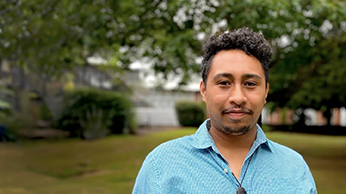Source: NZ Listener
A performance of Takerei Komene's te reo mass features one chorister who knows it very well.

If you've never had the experience, it's quite a thing to stand in the middle of a choir. The swirl of sound takes on a physical form; you feel it through your body. What must it be like to be in that maelstrom when the music you're singing is your own? And to perform it with your friends and colleagues, and be conducted by your teacher and mentor? That's pressure.
“I know the instrument I'm writing for,” reasons composer/singer Takerei Komene (Ngapuhi), who seems to be handling the prospect well enough. It must help that the instrument, Voices NZ Chamber Choir - of which Komene is a member - is so accomplished, and that the teacher/mentor is Karen Grylls CMNZ, music director of Voices, the national choir she founded in 1998. Grylls has included selections from Komene's mass, Miha, in its upcoming Horizons programme.
“Karen has been an incredible light in my life,” Komene says. The pair met in 2017 when Komene was still a student at Dilworth School and directing one of the school's choirs in national choral competition The Big Sing.
“She said that I must keep going with this, and that our paths would cross eventually.”
They did, and as well as singing with her choir, Komene studied under Grylls at the University of Auckland.
Miha, though, was written for neither Voices nor Grylls, but composed as a farewell gift to another group with which Komene sang, the Holy Trinity Cathedral choir, its conductor Rowan Johnston (also a member of Voices) and organist Philip Smith.
I'd been singing with them since 2018 and I wanted to give something back after all the music we'd made together,' Komene says.
So far as they can tell, Miha is the first full mass with text solely in te reo Maori. That matters to the composer. “I spend a lot of my time with a Western art form, one that I treasure and which is part of my life, but it is important to me that an element of home is at the centre of it.
“For the vast majority of the time, that goes back to the text, so a lot of my music is an integration of experience and the learning I've gained with this music - a lot of which has its roots in the Northern Hemisphere - with home: land and the language of my people. The language and the land are home for me.” I
"I wanted to give something back after all the music we'd made together."